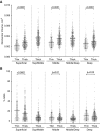Glomerular Volume and Glomerulosclerosis at Different Depths within the Human Kidney
- PMID: 31278193
- PMCID: PMC6683701
- DOI: 10.1681/ASN.2019020183
Glomerular Volume and Glomerulosclerosis at Different Depths within the Human Kidney
Abstract
Background: Age, CKD risk factors, and kidney function are associated with larger glomerular volume and a higher percentage of globally sclerotic glomeruli. Knowledge of how these associations may differ by cortical depth is limited.
Methods: To investigate glomerular volume and glomerulosclerosis across different depths of cortex, we studied wedge sections of the renal parenchyma from 812 patients who underwent a radical nephrectomy (for a tumor), separately characterizing glomeruli in the superficial (subcapsular), middle, and deep (juxtamedullary) regions. We compared the association of mean nonsclerotic glomerular volume and of glomerulosclerosis (measured as the percentage of globally sclerotic glomeruli) with age, obesity, diabetes, smoking, kidney function, and structural pathology in the superficial, middle, and deep regions.
Results: The superficial, middle, and deep regions showed significant differences in glomerular volume (0.0025, 0.0031, and 0.0028 µm3, respectively) and in glomerulosclerosis (18%, 7%, and 11%, respectively). There was a marked increase in glomerulosclerosis with age in the superficial region, but larger glomerular volume was not associated with age at any cortical depth. Glomerulosclerosis associated more strongly with arteriosclerosis and ischemic-appearing glomeruli in the superficial region. Hypertension, lower eGFR, and interstitial fibrosis associated with glomerulosclerosis and glomerular volume to a similar extent at any depth. Diabetes and proteinuria more strongly associated with glomerulosclerosis in the deep and middle regions, respectively, but neither associated with glomerular volume differently by depth. Obesity associated more strongly with glomerular volume in the superficial cortex.
Conclusions: Most clinical characteristic show similar associations with glomerulosclerosis and glomerulomegaly at different cortical depths. Exceptions include age-related glomerulosclerosis, which appears to be an ischemic process and is more predominant in the superficial region.
Keywords: Renal pathology; glomerulosclerosis; glomerulus; interstitial fibrosis; kidney biopsy; risk factors.
Copyright © 2019 by the American Society of Nephrology.
Figures





References
-
- Trueta J, Barclay AE, Daniel PM, Franklin KJ, Prichard MML: Studies of the Renal Circulation, Springfield, Charles C. Thomas, 1947
-
- Jamison RL: Intrarenal heterogeneity. The case for two functionally dissimilar populations of nephrons in the mammalian kidney. Am J Med 54: 281–289, 1973 - PubMed
Publication types
MeSH terms
Grants and funding
LinkOut - more resources
Full Text Sources
Medical
Research Materials
Miscellaneous

